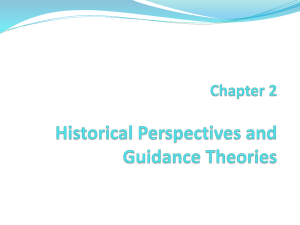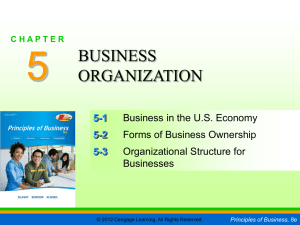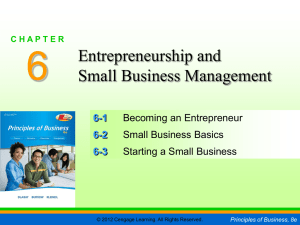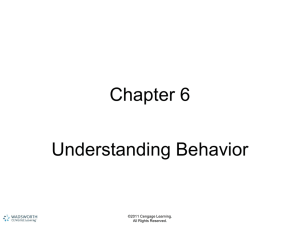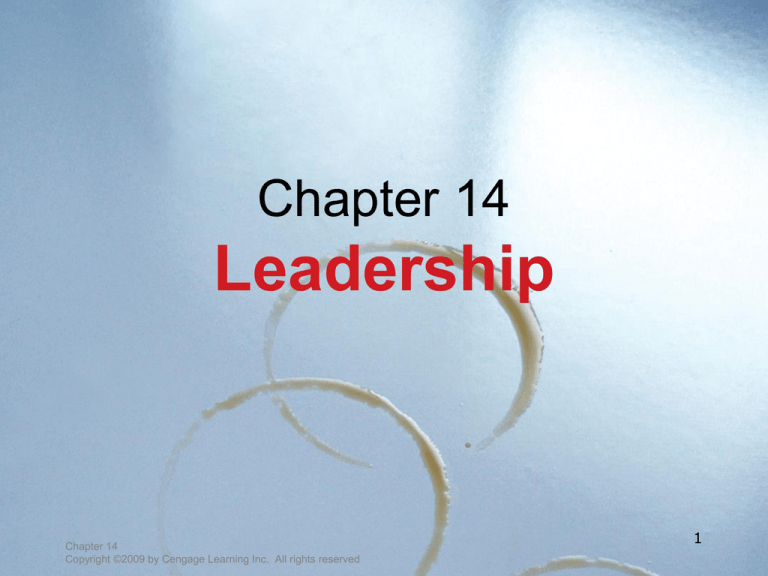
Chapter 14
Leadership
Chapter 14
Copyright ©2009 by Cengage Learning Inc. All rights reserved
1
Leadership
Differences
Between
Leaders and
Managers
Leadership is the process of influencing others to
achieve group or organizational goals.
Management is getting work done (efficiently and
effectively) through others.
Substitutes
for
Leadership
1
Chapter 14
Copyright ©2009 by Cengage Learning Inc. All rights reserved
4
Leaders versus Managers
MANAGERS
LEADERS
Do things right
Status quo
Short-term
Means
Builders
Problem solving
Do the right thing
Change
Long-term
Ends
Architects
Inspiring & motivating
1.1
Adapted from Exhibit 14.1
Chapter 14
Copyright ©2009 by Cengage Learning Inc. All rights reserved
5
Leaders versus Managers
American organizations (and probably those in much
of the rest of the industrialized world) are under led
and over managed. They do not pay enough
attention to doing the right thing, while they
pay too much attention to doing things right.
--Warren Bennis
1.1
Chapter 14
Copyright ©2009 by Cengage Learning Inc. All rights reserved
6
Doing the Right Thing
The Three M’s: Mission, Mentor, and Mirror
Business leaders can develop personal ethics by
focusing on their mission, a mentor, and the mirror
1. Develop a personal mission statement.
2. Take care in choosing a mentor.
3. Stand in front of the mirror to assess your
ethical performance as a business leader.
1.1
Chapter 14
Copyright ©2009 by Cengage Learning Inc. All rights reserved
7
Substitutes for Leadership
Leadership substitutes
subordinate, task, or organizational characteristics that
make leaders redundant or unnecessary
Leadership neutralizers
subordinate, task, or organizational characteristics that
interfere with a leader’s actions
Leaders don’t always matter
Poor leadership is not the cause of every
organizational crisis
1.2
Chapter 14
Copyright ©2009 by Cengage Learning Inc. All rights reserved
8
Who Leaders Are and What Leaders Do
Leadership
Traits
Leadership
Behavior
Trait theory: effective leaders possess a similar set
of traits or characteristics. Also called the “great person
theory. For example: good leaders are taller???
2
Chapter 14
Copyright ©2009 by Cengage Learning Inc. All rights reserved
10
Leadership Traits
Desire
to Lead
Honesty
and
Integrity
Drive
SelfBusiness
Honesty/Integrity=
knowledge=lengthy
being truthful
experience
and doing
inConfidence
the
whatindustry,
they
Self
Emotional
Cognitive
Desire
confidence:
to
lead=want
stability=even
ability=capacity
believing
to
be
in
tempered
to
one’s
in
analyze
charge,
ability
and
complex
influence
consistent
information
others.
Drive=highkey
level
ofsaid
effort,
achievement,
motivation,
etc.
understand
decisions
they
and
would
concerns
do. facing
the company.
Leadership
Traits
Knowledge
of the
Business
2.1
Emotional
Stability
Cognitive
Ability
Chapter 14
Copyright ©2009 by Cengage Learning Inc. All rights reserved
Adapted from Exhibit 14.3
11
Biz Flix: U-571
• What aspects of
leadership does
Dahlgren say are
important for submarine
commanders?
•Which leadership
behaviors or traits
does he emphasize?
Take Two Video
Click
•Are these traits or behaviors right for the
situation? Why or Why not?
Chapter 14
Copyright ©2009 by Cengage Learning Inc. All rights reserved
12
Leadership Behaviors
Initiating Structure
The degree to which a leader structures the
roles of followers by setting goals, giving
directions, setting deadlines, and assigning
tasks.
Consideration
The extent to which a leader is friendly,
approachable, and supportive and shows
concern for employees.
2.2
Lee Scott, WalMart
Chapter 14
Copyright ©2009 by Cengage Learning Inc. All rights reserved
15
Blake/Moulton Leadership
Grid
High 9
1,9
Concern for People
8
Team 9,9
Management
7
6
Middle of the
5,5
Road
5,5
5
4
Which style of management is best?
3
2
Low 1
2.2
Country Club
Management
Impoverished
1,1 Management
1
Low
2
3
4
AuthorityCompliance
5
6
7
Concern for Production
Chapter 14
Copyright ©2009 by Cengage Learning Inc. All rights reserved
8
9,1
9
High
Adapted from Exhibit 14.4
16
Putting Leaders in the Right Situation:
Fiedler’s Contingency Theory
Situational
Favorableness
Group
Performance
=
Leadership
Style
Fiedler‘s theory says that leaders are
effective when the work groups they lead
perform well.
Adapted From Exhibit 14.5
3
Chapter 14
Copyright ©2009 by Cengage Learning Inc. All rights reserved
18
Putting Leaders in the Right Situation:
Fiedler’s Contingency Theory
Least Preferred Coworker
Situational Favorableness
Matching Leadership Styles
to Situations
3
Chapter 14
Copyright ©2009 by Cengage Learning Inc. All rights reserved
19
Leadership Style:
Least Preferred Coworker
Leadership style is the way a leader
generally behaves toward followers
seen as stable and difficult to change
Style is measured by the Least Preferred
Co-worker scale (LPC)
3.1
relationship-oriented
task-oriented
Chapter 14
Copyright ©2009 by Cengage Learning Inc. All rights reserved
20
Leadership Style:
Least Preferred Coworker Scale
Adapted From Exhibit 14.6
3.1
Chapter 14
Copyright ©2009 by Cengage Learning Inc. All rights reserved
21
Situational Favorableness
Situational Favorableness
The degree to which a particular situation
either permits or denies a leader the chance to
influence the behavior of group members.
Three factors:
Leader-member relations Is the leader trusted?
Subordinate tasks clearly defined?
Task structure
Position power Can leader hire, fire, etc.?
3.2
Chapter 14
Copyright ©2009 by Cengage Learning Inc. All rights reserved
22
Situational Favorableness
Adapted from Exhibit 14.7
3.2
Chapter 14
Copyright ©2009 by Cengage Learning Inc. All rights reserved
23
Matching Leadership Styles to
Situations
Adapted from Exhibit 14.8
3.3
Chapter 14
Copyright ©2009 by Cengage Learning Inc. All rights reserved
24
Path-Goal Theory
Path-Goal Theory
A leadership theory that
states that leaders can
increase subordinate
satisfaction and
performance by
clarifying and clearing
the paths to goals and by
increasing the number
and kinds of rewards
available for goal
attainment.
In contrast to Fiedler’s contingency theory,
4
path-goal theory assumes that leaders can
change and adapt their leadership styles.
Chapter 14
Copyright ©2009 by Cengage Learning Inc. All rights reserved
25
Basic Assumptions of Path-Goal Theory
Clarify paths to goals
Clear paths to goals by solving problems
and removing roadblocks
Increase the number and kinds of rewards
available for goal attainment
Do things that satisfy followers today or will
lead to future rewards or satisfaction
4
Offer followers something unique and valuable
beyond what they’re experiencing
Chapter 14
Copyright ©2009 by Cengage Learning Inc. All rights reserved
Adapted From Figure 14.9
26
Path-Goal Theory
Subordinate Contingencies
•Perceived Ability
•Locus of Control
•Experience
Leadership Styles
•Directive
•Supportive
•Participative
•Achievement-Oriented
Outcomes
•Subordinate satisfaction
•Subordinate performance
Environmental Contingencies
4
•Task Structure
•Formal Authority System
•Primary Work Group
Chapter 14
Copyright ©2009 by Cengage Learning Inc. All rights reserved
Adapted From Figure 14.10
27
Adapting Leader Behavior:
Path-Goal Theory
Leadership
Styles
Subordinate
and
Environmental
Contingencies
Outcomes
4
Chapter 14
Copyright ©2009 by Cengage Learning Inc. All rights reserved
28
Leadership Styles
Directive
clarifying expectations and guidelines
Supportive
being friendly and approachable
Participative
allowing input on decisions
Achievement-Oriented
4.1
setting challenging goals
Chapter 14
Copyright ©2009 by Cengage Learning Inc. All rights reserved
29
Leadership Styles
Martin
Winterkorn
of Audi uses
a directive
style. His
employees
know exactly
what is
expected of
them.
Chapter 14
Copyright ©2009 by Cengage Learning Inc. All rights reserved
30
Subordinate and
Environmental Contingencies
Subordinate
Environmental
Perceived ability
Task structure
Locus of control
Formal authority
system
Experience
Primary work group
The organizations
amount
ofwhich
work-oriented
participation
extent
to
people believe
theyor
The
established
set
ofthat
procedures,
How
much
ability
subordinates
believe
they
The
ofsupport
experience
of
the subordinates
Thelevel
degree
to
which
the
requirements
ofina
emotional
that
is
provided
by
the
have
control
over
what
happens
to
them
rule,
and
policies.
have for doing their jobs well.
subordinate’s
tasks arework
clearly
specified.
employee’s
immediate
group.
life.
4.2
Chapter 14
Copyright ©2009 by Cengage Learning Inc. All rights reserved
31
Path Goal Theory:
When to Use Leadership Styles
Directive Leadership
Unstructured tasks
Inexperienced workers
Workers with low perceived ability
Workers with external locus of
control
Unclear formal authority system
Supportive Leadership
Structured, simple, repetitive
tasks
Stressful, frustrating tasks
When workers lack confidence
Clear formal authority system
Participative Leadership
Achievement-Oriented Leadership
Experienced workers
Unchallenging tasks
Workers with high perceived ability
Workers with internal locus of
control
Workers not satisfied with rewards
Complex tasks
Adapted from Exhibit 14.11
4.2
Chapter 14
Copyright ©2009 by Cengage Learning Inc. All rights reserved
32
Adapting Leadership Behavior
Hersey and Blanchard’s Situational Leadership Theory
Worker
Readiness
Leadership
Styles
Situational leadership theory states that
leaders need to adjust their leadership styles
to match their followers’ readiness.
5
Chapter 14
Copyright ©2009 by Cengage Learning Inc. All rights reserved
33
Worker Readiness
The ability and willingness to take responsibility for directing
one’s behavior at work
Components of worker readiness:
Job readiness
Psychological readiness
5.1
Chapter 14
Copyright ©2009 by Cengage Learning Inc. All rights reserved
34
Worker Readiness
5.1
R4
confident
willing
able
R3
insecure
not willing
able
R2
confident
willing
not able
R1
insecure
not able
not willing
Chapter 14
Copyright ©2009 by Cengage Learning Inc. All rights reserved
35
Leadership Styles
Telling
(R1)
high task behavior
low relationship behavior
Selling
(R2)
high task behavior
high relationship behavior
Participating
(R3)
low task behavior
high relationship behavior
Delegating
(R4)
low task behavior
low relationship behavior
5.2
Chapter 14
Copyright ©2009 by Cengage Learning Inc. All rights reserved
36
Approaches to Leadership
Traits
Behaviors
Situational theories
Strategic leadership
Visionary
• Charismatic leadership
• Transformational leadership
Chapter 14
Copyright ©2009 by Cengage Learning Inc. All rights reserved
44
Visionary Leadership
Charismatic
Leadership
Transformational
Leadership
7
Chapter 14
Copyright ©2009 by Cengage Learning Inc. All rights reserved
45
Charismatic Leadership
Creates an exceptionally strong relationship
between leader and follower
Charismatic leaders:
articulate a clear vision, based on values
model values consistently with vision
communicate high performance expectations
display confidence in followers’ abilities
7.1
Chapter 14
Copyright ©2009 by Cengage Learning Inc. All rights reserved
46
Kinds of Charismatic Leaders
Ethical Charismatics
provide developmental opportunities
open to positive and negative feedback
recognize others’ contributions
share information
concerned with the interests of the group
Unethical Charismatics
7.1
control and manipulate followers
do what is best for themselves
only want positive feedback
motivated by self-interest
Chapter 14
Copyright ©2009 by Cengage Learning Inc. All rights reserved
47
Ethical and Unethical
Charismatic Leaders
Charismatic Leader
Behaviors
Ethical Charismatics
Exercising Power
Power is used to serve others
Creating the vision
Followers help develop the vision
Communicating with
followers
Two-way communication
Accepting feedback
Open to feedback
Stimulating followers
Want followers to think and to questions the
status quo
Developing followers
Focus on developing followers
Living by moral
standards
Three virtues: courage, sense of fairness,
integrity
7.1
Chapter 14
Copyright ©2009 by Cengage Learning Inc. All rights reserved
Adapted from Exhibit 14.15
48
Ethical and Unethical
Charismatic Leaders
Charismatic Leader
Behaviors
Unethical Charismatics
Exercising Power
Power is used to dominate others
Creating the vision
Vision comes solely from the leader
Communicating with
followers
One-way communication, not open to input
from others
Accepting feedback
Prefer yes-men, punish candid feedback
Stimulating followers
Don’t want followers to think, prefer
uncritical acceptance of own ideas
Developing followers
Insensitive to followers’ needs
Living by moral
standards
Follow standards only if they satisfy
immediate self interests
7.1
Chapter 14
Copyright ©2009 by Cengage Learning Inc. All rights reserved
Adapted from Exhibit 14.15
49
Transformational Leadership
Generates awareness and
acceptance of group’s
purpose and mission
Gets followers to
accomplish more than they
intended or thought
possible
7.2
Chapter 14
Copyright ©2009 by Cengage Learning Inc. All rights reserved
51


